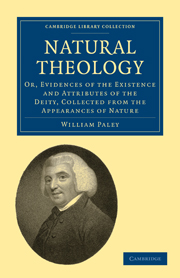 Natural Theology
Natural Theology Published online by Cambridge University Press: 07 September 2010
When we come to the elements, we take leave of our mechanics; becaufe we come to thofe things, of the organization of which, if they be organized, we are confeffedly ignorant. This ignorance is implied by their name. To fay the truth, our inveftigations are ftopped long before we arrive at this point. But then it is for our comfort to find, that a knowledge of the conftitution of the elements is not neceffary for us. For inftance, as Addifon has well obferved, “we know water fufficiently, when we know how to boil, how to freeze, how to evaporate, how to make it frefh, how to make it run or fpout out, in what quantity and direction we pleafe, without knowing what water is.” The obfervation of this excellent writer has more propriety in it now, than it had at the time it was made: for the conftitution, and the conftituent parts, of water, appear in fome meafure to have been lately difcovered; yet it does not, I think, appear, that we can make any better or greater ufe of water fince the difcovery, than we did before it.
We can never think of the elements without reflecting upon the number of diftinct ufes which are confolidated in the fame fubftance. The air fupplies the lungs, fupports fire, conveys found, reflects light, diffufes fmells, gives rain, wafts fhips, bears up birds.
To save this book to your Kindle, first ensure [email protected] is added to your Approved Personal Document E-mail List under your Personal Document Settings on the Manage Your Content and Devices page of your Amazon account. Then enter the ‘name’ part of your Kindle email address below. Find out more about saving to your Kindle.
Note you can select to save to either the @free.kindle.com or @kindle.com variations. ‘@free.kindle.com’ emails are free but can only be saved to your device when it is connected to wi-fi. ‘@kindle.com’ emails can be delivered even when you are not connected to wi-fi, but note that service fees apply.
Find out more about the Kindle Personal Document Service.
To save content items to your account, please confirm that you agree to abide by our usage policies. If this is the first time you use this feature, you will be asked to authorise Cambridge Core to connect with your account. Find out more about saving content to Dropbox.
To save content items to your account, please confirm that you agree to abide by our usage policies. If this is the first time you use this feature, you will be asked to authorise Cambridge Core to connect with your account. Find out more about saving content to Google Drive.